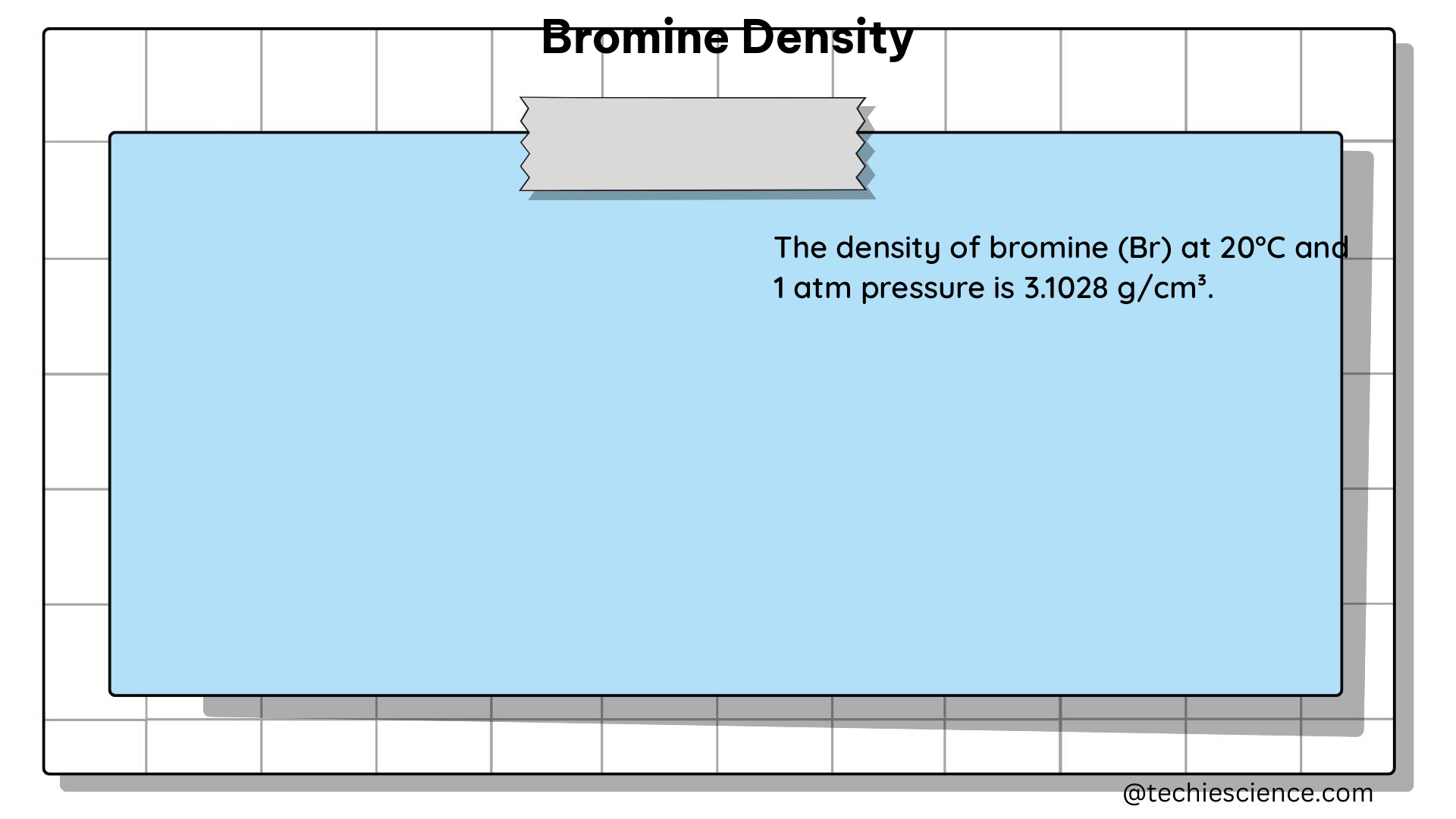Bromine is a dense, reactive liquid element that belongs to the halogen group of the periodic table. With a density of approximately 3.10 g/mL at room temperature, bromine is significantly denser than water, which has a density of around 1 g/mL. This unique property of bromine has numerous applications and implications in various fields of science and industry.
Understanding Bromine Density
The density of bromine can be calculated using the formula:
Density = Mass / Volume
At room temperature (approximately 20°C), the density of bromine is 3.10 g/mL. This means that one milliliter of bromine has a mass of about 3.10 grams. The high density of bromine is due to its atomic structure, which consists of a heavy nucleus surrounded by a large number of electrons.
Factors Affecting Bromine Density
The density of bromine can be influenced by several factors, including:
-
Temperature: The density of bromine decreases as the temperature increases. At higher temperatures, the molecules have more kinetic energy, causing them to occupy a larger volume and reducing the overall density.
-
Pressure: Increasing the pressure on bromine can cause its density to increase, as the molecules are compressed into a smaller volume.
-
Purity: The presence of impurities in bromine can affect its density. Highly pure bromine will have a density closer to the theoretical value of 3.10 g/mL.
Calculating Bromine Mass and Volume
Using the known density of bromine, you can calculate the mass or volume of a given sample. For example, if you have a sample of bromine that occupies a volume of 88.5 mL, you can calculate its mass using the formula:
Mass = Density × Volume
Mass = 3.10 g/mL × 88.5 mL = 274.35 g
Conversely, if you know the mass of a bromine sample, you can calculate its volume using the formula:
Volume = Mass / Density
Bromine Properties and Applications

Bromine is a unique element with several interesting properties and a wide range of applications:
Physical Properties
- Appearance: Bromine is a dark reddish-brown fuming liquid at room temperature.
- Boiling Point: The boiling point of bromine is 58.8°C (137.8°F).
- Melting Point: The melting point of bromine is -7.2°C (19.0°F).
- Solubility: Bromine is soluble in water and forms the bromide ion (Br-) when it reacts with other substances.
Chemical Properties
- Reactivity: Bromine is a highly reactive element and belongs to the halogen group of the periodic table.
- Oxidation State: Bromine typically has an oxidation state of -1 when it forms compounds.
- Compounds: Bromine can form a wide range of compounds, including hydrogen bromide (HBr), sodium bromide (NaBr), and organic compounds containing bromine.
Applications
- Flame Retardants: Bromine is used in the production of flame retardants, which are added to various materials to improve their fire resistance.
- Agricultural Chemicals: Bromine-based compounds are used as pesticides, fumigants, and soil disinfectants in agriculture.
- Pharmaceuticals: Bromine is used in the synthesis of certain pharmaceutical drugs and medical treatments.
- Disinfectants and Bleaching Agents: Bromine-based compounds are used as disinfectants and bleaching agents in water treatment, swimming pools, and other applications.
- Industrial Processes: Bromine is used in various industrial processes, such as the production of dyes, textiles, and electronics.
Bromine Density Numerical Examples
Here are some numerical examples to illustrate the calculations involving bromine density:
-
Example 1: If a sample of bromine has a mass of 274.35 grams, what is the volume of the sample?
Volume = Mass / Density
Volume = 274.35 g / 3.10 g/mL
Volume = 88.5 mL -
Example 2: What is the mass of 125 mL of bromine?
Mass = Density × Volume
Mass = 3.10 g/mL × 125 mL
Mass = 387.5 g -
Example 3: A container holds 500 mL of bromine. What is the mass of the bromine in the container?
Mass = Density × Volume
Mass = 3.10 g/mL × 500 mL
Mass = 1,550 g -
Example 4: If a bromine sample has a mass of 88.5 grams, what volume does it occupy?
Volume = Mass / Density
Volume = 88.5 g / 3.10 g/mL
Volume = 28.55 mL
These examples demonstrate how the density of bromine can be used to calculate the mass or volume of a given sample, which is essential in various scientific and industrial applications.
Conclusion
Bromine is a unique and fascinating element with a density of approximately 3.10 g/mL at room temperature. Understanding the density of bromine and its related properties is crucial in various fields, from chemistry and physics to industrial applications. By mastering the concepts and calculations presented in this guide, you can confidently work with bromine and leverage its unique characteristics to solve problems and advance your understanding of this remarkable element.
References:
- Course Hero. Density Bromine is a red-brown liquid with a density of 3.10 g/mL. A sample of bromine weighing 88.5 g occupies what volume? https://www.coursehero.com/textbook-solutions/density-bromine-is-a-red-brown-liquid-with-a-density-of-3-10-g-ml-a-sample-of-bromine-9781305580343-591/Chapter-1-Problem-180-1031846/
- PubChem. Bromine | Br2 | CID 24408. https://pubchem.ncbi.nlm.nih.gov/compound/Bromine
- Homework. Study.com. At room temperature, the element bromine is a liquid with a density of 3.12 g / m l. Calculate the mass of 125 mL of bromine. https://homework.study.com/explanation/at-room-temperature-the-element-bromine-is-a-liquid-with-a-density-of-3-12-g-ml-calculate-the-mass-of-125-ml-of-bromine.html
- Chemicool. Bromine (Br) Density. https://www.chemicool.com/elements/bromine.html
- Lenntech. Bromine (Br) – Chemical properties, health and environmental effects. https://www.lenntech.com/periodic/elements/br.htm

The lambdageeks.com Core SME Team is a group of experienced subject matter experts from diverse scientific and technical fields including Physics, Chemistry, Technology,Electronics & Electrical Engineering, Automotive, Mechanical Engineering. Our team collaborates to create high-quality, well-researched articles on a wide range of science and technology topics for the lambdageeks.com website.
All Our Senior SME are having more than 7 Years of experience in the respective fields . They are either Working Industry Professionals or assocaited With different Universities. Refer Our Authors Page to get to know About our Core SMEs.